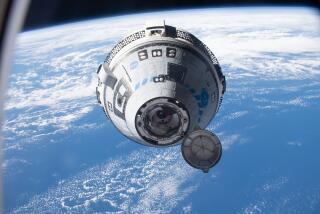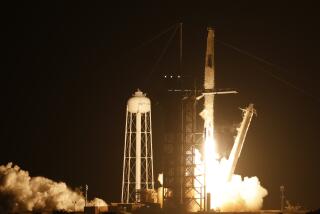Atlantis Crew Readies for Mir Docking : Shuttle: The meeting--the first in space of a Russian and U.S. craft in 20 years--is an extremely delicate operation that commander Robert Gibson likens to ‘threading a needle.’
- Share via
HOUSTON — The five astronauts and two cosmonauts aboard the shuttle Atlantis woke up on their first morning in space Wednesday to a rendition of “I Got You Babe”--a musical reference to today’s scheduled mating with the Russian Mir space station.
After taking care of housekeeping chores--switching on the scientific laboratory, Spacelab, and checking out cameras and lighting for the sunrise rendezvous--the crew got some exercise on a treadmill and prepared to catch up with Mir.
Atlantis was due to be positioned directly beneath Mir just after 4 a.m. today, on its way to the first meeting in space of a Russian and U.S. craft since the 1975 Soyuz-Apollo docking.
In a TV interview, Atlantis commander Robert L. (Hoot) Gibson said he was pleased that “we have a very challenging and rewarding program under way.”
The crew looked elated Wednesday, if a little green around the gills while floating from their seats like party balloons, even as straps held them somewhat in place. Space sickness tends to be worst on the first day in orbit, a spokesman at NASA’s Space Center here said.
In a preview of communications challenges to come, each question and answer had an echo as interpreters on the ground repeated the words in both English and Russian. NASA officials and crew members have said repeatedly that communication is their single biggest problem. Some 15 interpreters were to be available on the ground in Houston this morning--with nine more in Moscow--to ease things along.
As for the shuttle, it was operating “flawlessly,” NASA officials said, despite a minor leak in an oxygen tank and a laser radar gun that turned out not to have batteries.
After arriving just below Mir at sunrise, Atlantis was to remain 270 feet from the space station for about an hour, making sure the alignment was right and waiting until the two craft were over a Russian ground station to begin docking.
The docking was scheduled for 6 a.m. PDT, with hatch opening and ceremonies two hours later.
The mating is an extremely delicate operation, involving two 100-ton ships flying through space at 17,500 m.p.h. NASA officials have seemed particularly concerned about how the combined motion of the two craft would damp out--that is, two moving objects that grab onto each other tend to rotate around their common center, much like dancers who move toward each other, then twirl.
Mir and Atlantis must be stationary relative to one another before docking to avoid putting too much stress on the hooks and latches that will hold them together.
With a margin of error of only three inches, Gibson has described the docking as “much like threading a needle.”
He will get help from TV cameras that focus on targets placed on Mir. And pilot Gregory J. Harbaugh will use a laptop computer that receives information on the position from various sensors on Atlantis. At the point where virtual reality meets reality, crew members said, they might expect to feel a thud. There will be no sound, however, since sound waves cannot travel through empty space.
If the docking does not work for some reason, the crews could try again either one orbit later or one day later, depending on the nature of the problem.
The mission is to prepare the foundation for working with the Russians on the international space station, which also includes Japanese, European and Canadian partners. It is due to be ready for its first occupants in 2002.
More to Read
Sign up for Essential California
The most important California stories and recommendations in your inbox every morning.
You may occasionally receive promotional content from the Los Angeles Times.










